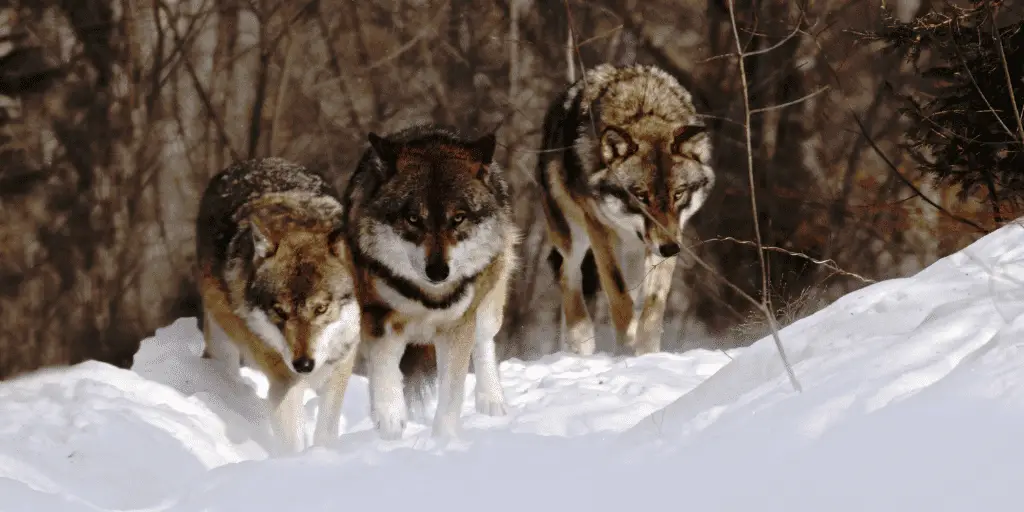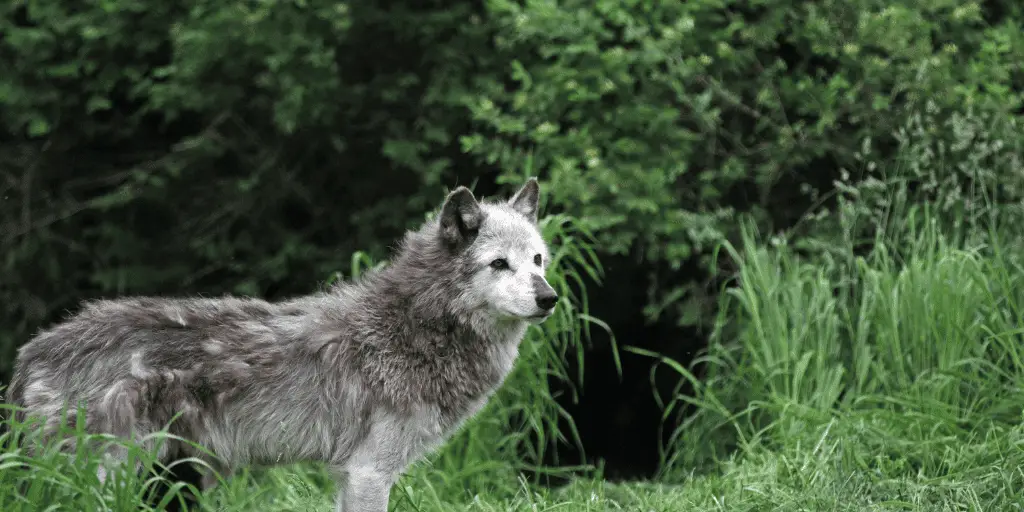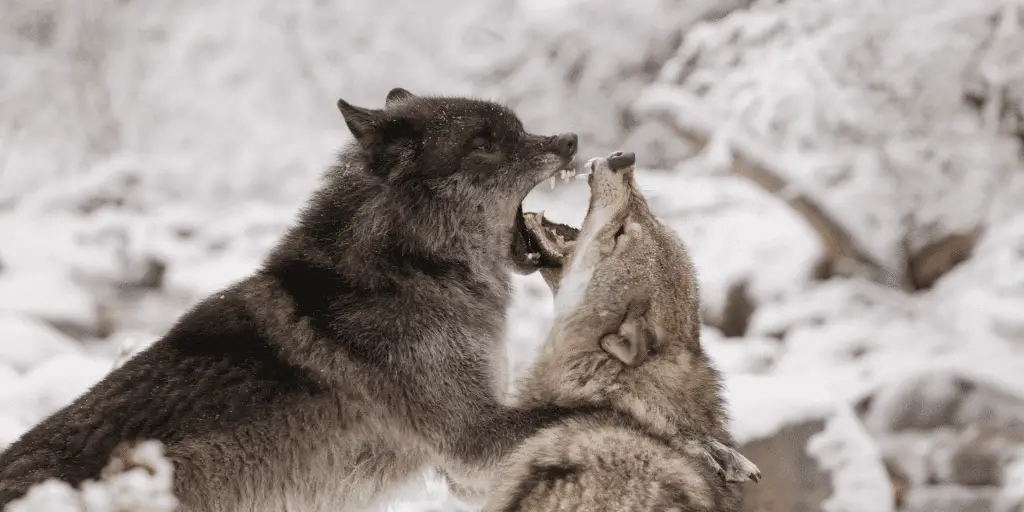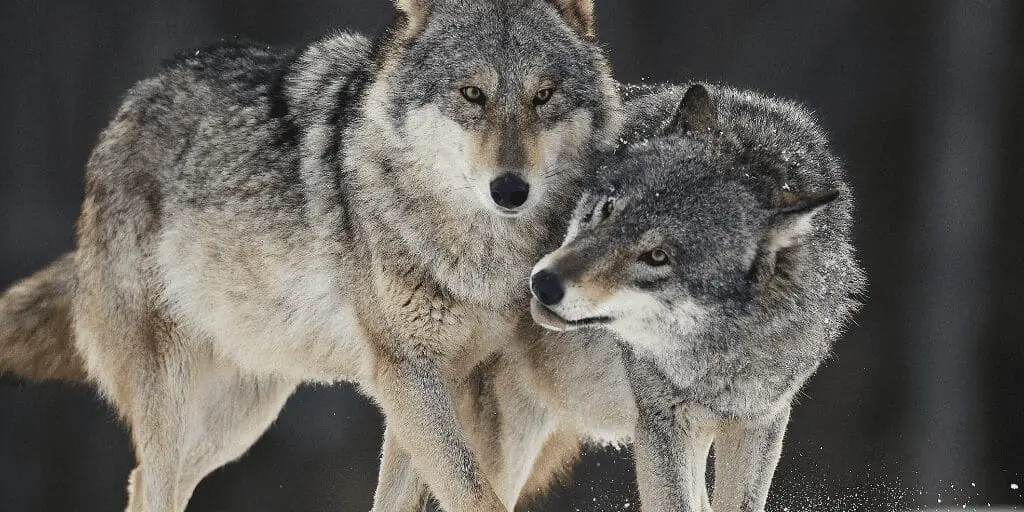Unveiling the mysteries of a wolf’s vision, this article delves into the intriguing question: Are wolves colorblind? Discover the world as seen through the eyes of these majestic predators, where survival hinges on a unique color perception. Learn how their dichromatic vision shapes their hunting prowess and pack dynamics, offering a rare glimpse into the evolutionary marvels of the animal kingdom.
Key Takeaways:
- Wolves have dichromatic vision, meaning they primarily see the world in shades of blue and yellow, unlike humans who have trichromatic vision and can see a broader range of colors. This adaptation aids their hunting, particularly at dawn and dusk.
- The absence of certain cone cells in wolves’ eyes means they cannot perceive red and green hues as humans do, likely seeing these colors as shades of grey or yellow. This limitation, however, does not significantly hinder their survival as carnivores.
- Wolves’ night vision is exceptional due to the presence of a reflective layer behind their retinas called the tapetum lucidum and a high density of rod cells, which enhances their ability to hunt in low-light conditions.
- While wolves may have limitations in color perception, they possess a highly developed sense of smell that plays a crucial role in their hunting strategy, allowing them to detect prey over long distances and navigate their environment effectively.
- The evolution of wolves’ vision, shaped by the need to hunt and survive in varying landscapes, demonstrates the adaptability of their sensory capabilities, with their dichromatic vision and night vision being key to their success as apex predators.
Are Wolves Colorblind?
Quick Answer: Wolves are not colorblind; they have dichromatic vision, seeing primarily in shades of blue and yellow, but not reds and greens.
| Aspect | Details |
| Vision Type | Dichromatic vision, seeing primarily in shades of blue and yellow. Unable to perceive reds and greens, likely seeing these colors as shades of grey or yellow. |
| Night Vision | Exceptional due to the tapetum lucidum and a high density of rod cells, enhancing low-light hunting capabilities. |
| Sensory Integration | Highly developed sense of smell complements visual limitations, crucial for hunting and navigating. |
| Evolutionary Adaptation | Vision adapted for hunting and survival in diverse landscapes. Dichromatic vision and night vision are key evolutionary traits for success as apex predators. |
| Impact on Hunting Tactics | Dichromatic vision aids in detecting prey at dawn and dusk by enhancing contrast. Night vision allows for effective hunting in low-light conditions. |
| Social Dynamics | Visual cues play a significant role in communication within packs, aiding in establishing hierarchy and coordinating during hunts. |
| Environmental Interaction | Adapted to navigate and interpret various landscapes efficiently. Visual memory helps in recognizing territory boundaries and detecting environmental changes. |
| Evolutionary Pathways | Evolved from early canids, adapting to open landscapes which shaped their sensory development for spotting and pursuing prey. Selective pressures from survival needs in the wild have refined their visual capabilities over generations. |
The Visual World of Wolves

Wolves inhabit a world that’s colored differently than ours, and it’s all thanks to their unique visual makeup. Their eyes are tuned to thrive in the wild, with a vision that’s adapted over millennia to suit their role as efficient predators. Understanding how wolves see can give us a glimpse into their lives and how they interact with the vast landscapes they roam.
Understanding Dichromatic Vision
Dichromatic vision is a term that might sound complex, but it’s simply a way of describing how an animal sees colors. Unlike humans, who have trichromatic vision and can see a wide range of colors, wolves have dichromatic vision.
This means they see the world primarily in shades of blue and yellow. The reds and greens that we can distinguish easily are likely perceived as nuances of their blue-yellow vision. This type of vision is particularly advantageous for wolves, especially when hunting at dawn or dusk.
The muted color palette helps them spot prey that blends into the natural environment, making them formidable hunters. Imagine looking through a camera filter that only captures blues and yellows; that’s somewhat akin to a wolf’s view of the world.
The Role of Cones in Color Perception
Diving deeper into the wolf’s eye, it’s the cones that are the real stars when it comes to color perception. Wolves have two types of cone cells, each sensitive to different wavelengths of light. These cones are what enable them to pick up on the blue and yellow hues. In contrast, humans have three types of cones, allowing for a broader spectrum of color detection.
When light enters a wolf’s eye, it’s these cones that translate it into the limited color information they perceive. While this means wolves might not see the full rainbow we do, their vision is perfectly attuned to their needs, helping them distinguish between the important elements in their environment, like the silhouette of a prey animal against the leafy background.
Color Perception and Behavioral Adaptations
Wolves’ dichromatic vision isn’t just about seeing colors; it’s deeply connected to their survival. Their ability to detect movement and subtle contrasts in their environment is key to their hunting success. For instance, the way a deer’s coat contrasts with the surrounding foliage can be more pronounced to a wolf’s eye, making it easier to target and track.
This visual adaptation has also influenced their social behaviors and how they communicate with pack members during hunts. The evolutionary push towards dichromatic vision has carved out wolves’ ecological niche, allowing them to excel as apex predators.
Observations from wildlife experts show that wolves’ hunting tactics are a dance of shadows and shapes, a testament to their specialized vision in the wild.
How Wolves See Colors
When you imagine the world through the eyes of a wolf, it’s easy to assume that their view might be a bit dull compared to the rich tapestry of color humans enjoy. However, wolves are not wandering through a monochrome world; they experience their own unique spectrum of colors.
Unlike humans who have trichromatic vision, wolves have dichromatic vision, meaning they see colors differently, with certain shades standing out more than others.
Blue and Yellow: The World Through Wolves’ Eyes
Wolves are not drawn into a world of greys as one might think when hearing the term “colorblind.” Instead, their eyes are fine-tuned to detect variations of blue and yellow. Imagine the early morning light casting a golden hue over the landscape or the twilight sky painted in shades of blue; these are the moments when a wolf’s vision comes alive.
The blue of the sky and the yellow of the sunlit forest are not just background colors but are vibrant and significant elements of a wolf’s environment. These colors can influence their hunting tactics, as the contrast helps them spot prey more easily, or navigate through their territory by distinguishing subtle changes in their surroundings.
The psychological effects of this color perception are still being explored, but it’s fascinating to consider how a preference for blue and yellow might affect a wolf’s behavior. For instance, wolves might be more attracted to areas bathed in these colors, which could have implications for their movement patterns and habitat selection.
Limitations in Wolves’ Color Vision
Despite their ability to see blues and yellows vividly, wolves do have their blind spots—reds and greens, for example, are not part of their visual repertoire. This dichromatic vision means that certain elements in their environment, like the red of ripe berries or the green of leafy shrubs, might not stand out as they do for us.
However, this isn’t much of a hindrance for these carnivorous creatures. Wolves rely less on color for foraging and more on their other keen senses, such as an exceptional sense of smell and remarkable night vision, to interact with the world around them.
Comparative studies have shown that while wolves may not see the full rainbow of colors that humans do, their vision is perfectly adapted to their ecological niche. The ability to see well in low light and pick up on the subtle movement of prey at dusk or dawn is far more critical to their survival than distinguishing between a red apple and a green one.
Their vision, though different, is by no means a limitation—it’s a testament to the incredible adaptability and specialization of the canine family.
Colors Beyond Wolves’ Perception

When picturing the world through the eyes of a wolf, it’s essential to understand that their vision is quite different from ours. Wolves are dichromatic, meaning they have two types of color receptors, or cone cells, in their eyes.
This limits their ability to perceive the full spectrum of colors that humans can see, particularly red and green. This dichromatic vision is due to the absence of the cone cells that detect these colors, a trait they share with many other mammals.
The ecological and behavioral implications of this are fascinating. For instance, wolves’ hunting strategies may not rely on the detection of red or green hues, which could affect their ability to spot prey that blends into foliage.
However, wolves are highly adaptable creatures, and they’ve evolved to integrate other sensory information to navigate and survive in their environments effectively.
Red and Green Through Wolves’ Eyes
Imagine a world where red roses and green grass don’t hold their familiar hues. For wolves, red and green likely appear as shades of gray or yellow. This altered perception means that wolves may not distinguish between ripe and unripe fruits based on color, and camouflaged prey in green foliage might be less visible.
However, it’s not just about food; the absence of red and green perception could also influence wolves’ social interactions, as visual cues can be an important part of animal communication. To put it in human terms, it’s akin to the way some people with color blindness might mix up red and green traffic lights or have trouble picking out a red apple in a sea of green leaves.
Compensatory Mechanisms in Wolves’ Vision
Despite their color vision limitations, wolves are by no means disadvantaged in the wild. They boast an impressive suite of compensatory mechanisms. Their night vision is particularly strong, allowing them to hunt in low-light conditions. Their hearing is sharp enough to detect the faintest rustles in the underbrush, and their sense of smell is so keen they can track a scent trail for miles.
These senses don’t operate in isolation; they blend to give wolves a rich perception of their surroundings. Studies have shown wolves tracking prey over long distances, navigating complex terrain, and maintaining intricate social structures—all without the need for a full spectrum of colors. This sensory integration is a testament to the adaptability of wolves and their ability to thrive in diverse habitats.
Night Vision in Wolves
When the sun dips below the horizon and the world tucks itself into the shadows, wolves come alive, their eyes shining with a special kind of magic that’s been honed through millennia of evolution.
This isn’t just the stuff of fairy tales; it’s the result of a finely tuned visual system that thrives in the dark. The secret to their exceptional night vision lies in both their anatomy and their behavior, which together create a formidable nocturnal hunter.
Anatomy of Wolves’ Night Vision
Peering into the eyes of a wolf, one might not immediately see the intricate design that makes them such effective night-time predators. But behind those glowing orbs is the tapetum lucidum, a layer that acts like a biological mirror.
It captures and reflects light back through the retina, giving photoreceptor cells a second chance to absorb light particles that might have otherwise slipped away. This means that even in low-light conditions, wolves can effectively double the amount of light available to them, which is something our human eyes simply can’t do.
The retina of a wolf is also densely packed with rod cells, far more than the cones that we rely on to see vibrant colors. Rods are the champions of dim light, sensitive to even the faintest glimmers, and excellent at picking up movement. This abundance of rod cells means that wolves can detect even the subtlest movements in the dark, a critical ability for tracking down their next meal.
Behavioral Adaptations Linked to Night Vision
Wolves’ night vision isn’t just a static anatomical feature; it’s a dynamic part of their very lifestyle. As twilight sets in, wolves begin to stir, their eyes perfectly adapted to the dimming light. They time their hunts to coincide with the hours when their prey is most active yet other predators are hindered by the darkness. This gives them a distinct edge, allowing them to stalk and chase with precision.
But it’s not all about the hunt. Night vision also plays a pivotal role in how wolves interact with one another. They use visual cues to communicate and coordinate with their pack members during nocturnal hunts, ensuring they work together seamlessly.
When it comes to defending their territory or navigating their vast ranges, the ability to see in the dark is invaluable, allowing them to move and respond to threats with confidence, regardless of the hour.
The Role of Smell in Wolves’ Hunting Strategy
While the conversation often centers on the visual prowess of wolves, it’s their nose that often leads the charge in a hunt. Imagine a world where every scent tells a story, a world where a whiff of the air can reveal what’s for dinner and where it’s hiding.
That’s the world wolves live in. Their hunting strategy is a multisensory masterpiece, with smell playing a leading role. When the forest is dense or the night is dark, it’s the scent on the wind that guides the wolf to its prey. The biological marvel behind this lies in their olfactory senses, which are fine-tuned to pick up the faintest of trails.
Wolves can detect odors over long distances, and this ability is crucial for marking territories, identifying the direction of prey, and even recognizing different members of their pack.
Biological Basis of Wolves’ Olfactory Acuity
Diving into the anatomy of a wolf’s nose is like exploring a sophisticated scent-detection lab. The olfactory epithelium, a specialized tissue inside the nose, is vast and covered with receptors that catch odor molecules. This large surface area, paired with a high concentration of olfactory receptors, gives wolves an exceptional sense of smell.
Compared to humans, wolves are like superheroes of scent, capable of distinguishing between a myriad of smells that we would never notice. Scientific studies have shown that wolves can not only detect prey miles away but also differentiate between the individual scents of their pack members.
This level of sensitivity is a testament to the critical role that smell plays in their survival and interaction with the environment.
Integration of Smell and Vision in Hunting
Wolves are not just about a keen nose; they’re strategic hunters who know how to combine their senses for maximum impact. They might start with a scent, letting their noses guide them through the underbrush or across a field.
Once they’re close, their vision takes over to track and pursue the prey. Environmental factors like wind direction and terrain play into this strategy, influencing how and when wolves switch from nose to eyes.
And let’s not forget the teamwork. Wolf packs are the epitome of cooperative hunting, with each member playing a role, communicating, and coordinating through a complex dance of scents and sights. This synergy of smell and vision is what makes wolves such formidable hunters, capable of orchestrating hunts that are as efficient as they are effective.
Comparison with Other Animals

When we peek into the animal kingdom, we find a fascinating tapestry of sensory adaptations, each tailored to the unique demands of different species’ environments and lifestyles. To understand where wolves fit into this rich mosaic, it’s helpful to compare their sensory capabilities—specifically vision and smell—with those of other animals.
The types of vision, such as dichromatic versus trichromatic, night vision capabilities, and olfactory acuity, are all key factors that reflect the ecological roles and survival strategies of various creatures.
Vision Adaptations Across Species
Imagine seeing the world through different lenses—this is the reality for many animals. Wolves, for instance, have dichromatic vision, which is believed to aid them in detecting movement and shapes rather than a broad spectrum of colors.
This contrasts with the trichromatic vision of primates, which allows them to discern fine color details, aiding in tasks like selecting ripe fruits. Birds of prey take it even further with tetrachromatic vision, including the perception of ultraviolet light, which is crucial for spotting prey from great heights or detecting the urine trails of small mammals.
Night vision is another critical adaptation. Wolves, with their nocturnal habits, have eyes that are optimized for low-light conditions, allowing them to hunt effectively during dawn, dusk, or under the cover of night. This capability is shared by other nocturnal hunters, such as owls, whose eyes are highly adapted to see in the dark.
The evolutionary push for these adaptations often stems from the need for stealth, hunting efficiency, and the ability to navigate complex environments after sundown.
Olfactory Capabilities in the Animal Kingdom
Moving from sight to scent, the animal kingdom exhibits a wide array of olfactory capabilities. Wolves, with their keen sense of smell, can detect odors over a mile away, which is essential for tracking prey, finding mates, and social communication.
Bears, with their incredibly acute sense of smell, can sniff out food from even greater distances, while sharks use their olfactory prowess to detect minute quantities of blood in vast oceans.
On the other hand, some species rely less on their noses and more on other senses like vision or hearing. The balance of sensory reliance is a testament to the diverse survival strategies in nature. Wolves also use pheromones and scent marking to define their territories, a practice seen in various forms across many species, from the urine marking of big cats to the complex chemical communication of insects.
Sensory Integration for Survival
Wolves don’t just rely on a single sense; they integrate multiple senses to interact with their world. This sensory integration is key to their survival, enhancing their abilities in hunting, foraging, social interactions, and predator avoidance. Similarly, bats combine their acute hearing with echolocation to navigate and hunt in the dark, while sharks detect electromagnetic fields to locate prey.
This integration of senses is a common evolutionary theme, illustrating that while the specific senses and their acuities may differ, the principle of using combined sensory information for survival is widespread. Through these comparisons, we gain a deeper appreciation for the complexity of animal behavior and the ingenious ways life adapts to the challenges of existence.
Understanding Wolves Through Their Vision
Wolves are fascinating creatures, and their vision plays a crucial role in their daily lives. While they may not see the world in the same vibrant spectrum of colors that humans do, their vision is finely tuned to their needs as predators and pack animals.
The dichromatic vision of wolves, which limits them to seeing primarily in shades of blue and yellow, is more than compensated for by their exceptional night vision. This unique combination of visual strengths and limitations has a profound impact on their hunting tactics, social interactions, and survival strategies.
Hunting Tactics Shaped by Vision
When it comes to hunting, wolves are masters of strategy, and their vision is a key component of their success. They are particularly adept at detecting movement, even in the dimmest light, which is crucial when tracking prey during dawn, dusk, or nighttime. This ability to see in low-light conditions gives them a significant advantage over their prey.
In the realm of pack hunting, visual cues are vital. Wolves use body language and eye contact to communicate silently and coordinate their movements with precision. For instance, a slight change in posture can signal the pack to initiate a chase, while maintaining eye contact helps in aligning their attack.
These visual strategies are not just effective; they are essential for wolves to hunt efficiently and effectively.
Social Dynamics and Communication
Within the complex social structure of a wolf pack, vision is a key medium for communication. Subtle visual signals, such as variations in posture, the positioning of tails, and the intensity of eye contact, convey a wealth of information among wolves.
These cues help establish and reinforce the hierarchy within the pack, playing a critical role in determining dominance and submission. Visual communication also extends to mating rituals and the rearing of pups, where eye contact and body language serve as important tools for teaching and bonding.
Wolves’ dichromatic vision and enhanced night vision are perfectly suited for their ecological niche. These visual adaptations allow them to navigate through a variety of landscapes with confidence. Whether moving stealthily through a dense forest or scanning the horizon on an open plain, wolves rely on their sight to guide them.
Their visual memory aids in recognizing the boundaries of their territory and in detecting subtle changes in their environment, such as the encroachment of other predators or shifts in prey availability.
By integrating visual information with their other senses, wolves maintain a keen awareness of their surroundings, ensuring their continued survival and status as apex predators.
The Evolution of Wolves’ Vision

The visual prowess of wolves is not merely a happenstance but a testament to the relentless march of evolution. As descendants of the canid family, wolves have inherited and refined their sensory capabilities over countless generations.
Their journey through time has equipped them with a vision finely tuned for the demands of their environment, making them one of the most adaptable and formidable predators on the planet.
Ancestral Origins and Evolutionary Pathways
The canid lineage, rich with diversity, has given rise to the modern wolf, a creature whose visual acuity is rooted in its ancestral past. The evolutionary odyssey began with early canids, whose survival hinged on hunting and foraging within dense forests. As these environments gave way to open landscapes, a pivotal shift occurred.
The need to spot and pursue prey across vast distances sculpted the wolf’s sensory development, leading to a dichromatic vision that excels in detecting movement and subtle contrasts. Paleontological records, alongside genetic markers, narrate this transformation, revealing the incremental steps through which wolves honed their visual capabilities to match the demands of their ever-changing world.
Selective Pressures and Adaptation
The relentless demands of survival in the wild have acted as the crucible for the evolution of wolves’ vision. The cover of night, a time when many prey animals let down their guard, presented wolves with both a challenge and an opportunity. To capitalize on this, wolves developed exceptional night vision, allowing them to navigate and hunt in low-light conditions.
This adaptation, coupled with an acute sense of motion detection, has solidified their status as apex predators. The evolutionary narrative of wolves is echoed in the myriad of adaptations seen across the animal kingdom, where each species has carved out its niche through a unique set of sensory tools forged by similar environmental challenges.
The Role of Vision in Wolves’ Survival and Reproduction
For wolves, vision is more than a means of perceiving the world; it is a critical component of their survival and reproductive toolkit. The subtle interplay of body language and eye contact during pack hunts speaks to the sophistication of their visual communication.
This coordination is key to their hunting strategy, directly influencing their success and the well-being of the pack. Beyond the hunt, visual acuity plays a pivotal role in selecting mates, establishing territories, and nurturing offspring.
These behaviors, underpinned by visual cues, ensure that wolves not only survive but thrive, passing on their adept visual traits to future generations. The story of wolves’ vision is one of adaptation and survival, a narrative that continues to unfold in the wild landscapes they roam.
Conclusion
In conclusion, wolves possess dichromatic vision, seeing primarily in shades of blue and yellow, which is perfectly adapted to their needs as nocturnal hunters and pack animals. They may not perceive the full spectrum of colors that humans do, but their exceptional night vision and ability to detect movement and subtle contrasts greatly aid in their hunting tactics and social interactions.
While reds and greens may appear differently to them, this limitation is offset by their other keen senses, such as smell and hearing, which are crucial for tracking prey and communicating within the pack.
Comparative studies with other animals highlight the specialized nature of wolves’ sensory adaptations, reflecting their evolutionary journey and the selective pressures they have faced. Ultimately, wolves’ vision, though different from our own, is a testament to their survival and success as apex predators in diverse habitats.








